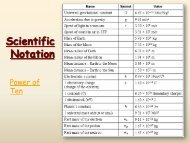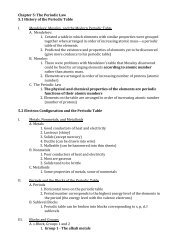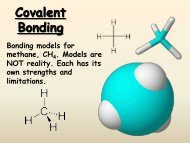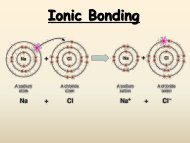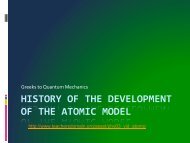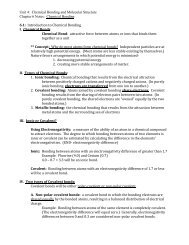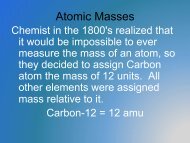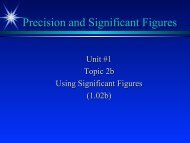The Periodic Table
The Periodic Table
The Periodic Table
Create successful ePaper yourself
Turn your PDF publications into a flip-book with our unique Google optimized e-Paper software.
<strong>The</strong><strong>Periodic</strong><strong>Table</strong>
<strong>The</strong>worldsfirst viewof theperiodictable. Firstpublishedin German.
Mendeleev’s <strong>Periodic</strong><strong>Table</strong>Dmitri Mendeleev
Modern Russian <strong>Table</strong>
there were 56 knownts with a new elementiscovered at a rate ofimately one per year. Aof organizing the<strong>The</strong> page fromMendeleev’s notebookwhere he worked out the1 st periodic table.Mendeleevrst <strong>Periodic</strong> <strong>Table</strong>
After Mendeleev placed all theknown elements in his periodictable, several empty spaces wereleft.In 1871 Mendeleev predicted theexistence and properties ofelements that would fill three of thespaces.
By 1886, all three of these elementshad been discovered.
Misplaced elements of iodine + telluriumHeavy elements did not fit well into his table<strong>The</strong>re was no room for new families ofelementsProblems with the Mendeleev’s <strong>Table</strong>• Iodine and Tellurim• Noble gases had not been discoveredA New Family of Elements94hn William Strutt,d Baron Rayleigh1894: John William Struttdiscovered Argon, the firstnoble gas to be discovered.(A New Family is added.) 1895n English physicist who, withilliam Ramsay, discovered theement argon (Ar), an achievementWilliam RamsayThree morer which he earned the Nobel Prize for Physics“noble gases”1904.1895: William Ramsaydiscovers three more“noble gases”: Krypton,Xenon, and Neon<strong>The</strong>se werediscoveredwhen Ramsaycooled asample of airuntil it became a liquid, then warmed the liquidand captured the gases one by one as theyrgon is present in the Earth's atmosphere at94% (3 rd in proportion after nitrogen andygen). Argon has approximately the samelubility in water as oxygen gas and is 2.5 timesore soluble in water than nitrogen gas. Argon is
In 1911, the English scientist HenryMoseley discovered that theelements fit into patterns better whenthey were arranged according toatomic number, rather than atomicweight.<strong>The</strong> <strong>Periodic</strong> Law states that thephysical and chemical properties ofthe elements are periodic functions oftheir atomic numbers.
Henry Moseley - 1913law.When World War Istarted, Moseley leftOxford University toenlist in the RoyalEngineers. He waskilled by a sniperduring the Battle ofGallipoli in 1915, atthe age of 27.Moseley to put the
<strong>The</strong> <strong>Periodic</strong> <strong>Table</strong><strong>The</strong>re are 92naturally occurringelements.
Periods and Blocks of the <strong>Periodic</strong> <strong>Table</strong>Elements are arranged vertically in theperiodic table in groups that share similarchemical properties.Elements are also organized horizontallyin rows,or periods.<strong>The</strong> length of each period is determinedby the number of electrons that canoccupy the sublevels being filled in thatperiod.
<strong>The</strong> periodic table is divided into fourblocks, the s, p, d, and f blocks. <strong>The</strong>name of each block is determined bythe electron sublevel being filled in thatblock.
Relationship Between <strong>Periodic</strong>ityand Electron Configurations





